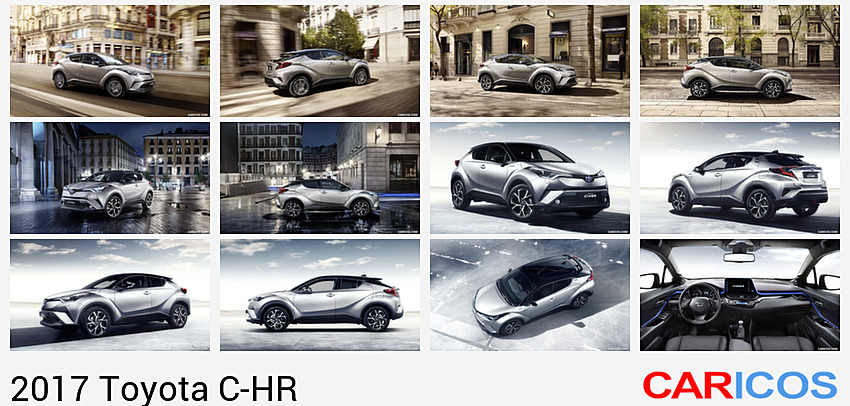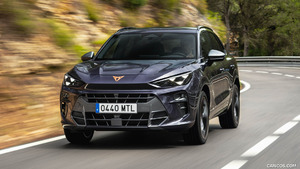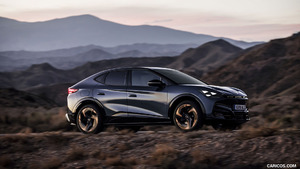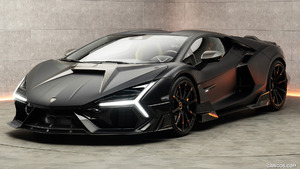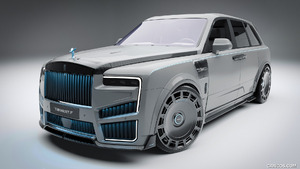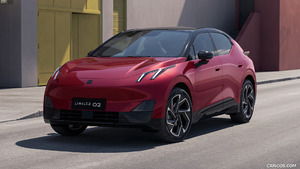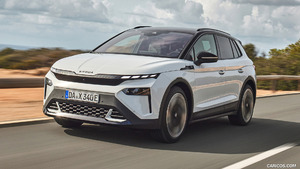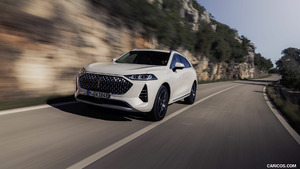Toyota C-HR
'The C-HR gives Toyota a powerful new presence in the growing C crossover segment. It is intended to spearhead a new movement within its segment -to create a new frontier. That's why we decided it had to be unique: with its own personality, full of originality.'
Kazuhiko Isawa, Chief Designer C-HR
Designed to stand out both within the Toyota line-up and in its segment, the all-new C-HR – or Coupé High-Rider - represents Akio Toyoda’s determination to allow greater stylistic freedom and promote engineering creativity in order to achieve eye-catching designs and enhanced driving pleasure.
The Toyota C-HR remains remarkably true to the general features of the concept-cars that attracted so much public attention in Paris in 2014 and in Frankfurt in 2015. Its coupe-like lines are a testimony to the resolve of its designers to create a style that stands out in the Toyota range, and to establish a new direction amongst mid-sized crossovers.
With the C-HR, Toyota targets a clear and singular customer profile. Predominantly driven by emotional considerations, these customers want individuality, and to be the first to try new experiences and products. Style and quality are essential considerations in any purchase they make, and the car is an extension of their personality.
Inspired by what he learned from meeting with these customers, C-HR Chief Engineer Hiroyuki Koba focused persistently on their requirements throughout the development process, setting high demands for design and perceived quality.
 2017 Toyota C-HR
2017 Toyota C-HR
The Toyota C-HR’s unique character demonstrates the flexibility that the TNGA (Toyota New Global Architecture) gives to vehicle developers in the three key areas of design, powertrain and dynamics, enabling them to deliver a new and fresh take on the increasingly commoditized crossover segment.
Pre-sales will begin throughout Europe in September, with the first deliveries to customers before the end of the year. Positioned between the Auris TS and the RAV4, C-HR targets upwards of 100,000 annual European sales.
A New Design Direction for the Crossover Segment
'Crossover users want something special, something that a traditional SUV cannot offer. They want a high driving position, but they don’t want the boxy shape of an off-roader. And they also want an agile driving feel.
With the C-HR, we are trying to introduce a new value into the C crossover market, and that newness comes from SUV robustness and strength. But we're not trying to make an SUV that's dynamic, rather, a dynamic vehicle with SUV-like properties.'
Kazuhiko Isawa, Chief Designer C-HR
The all-new Toyota C-HR introduces a distinctive styling that brings newfound dynamism and sensuality to the crossover market.
4360mm long, 1795mm wide, 1555mm high (Hybrid) and with a 2640mm wheelbase, the production vehicle remains remarkably true to the concept car’s exterior which was first shown at the Paris Motorshow in 2014, and which registered extremely well with target customers.
Under the concept of “Sensual Speed-Cross”, and featuring a diamond architectural theme with wheel arches projecting prominently at all four corners to emphasise the new crossover’s strength and rigidity, the C-HR modulated structure combines a powerful lower body and raised ground clearance with the slim and sleek cabin profile of a coupe.
Viewed from any angle, the C-HR's combination of facetted gemstone-like shapes with fluid surfaces and elegantly integrated detailing create a delicate balance of precision and sensuality.
The front represents a further development of Toyota’s Under Priority and Keen Look design identity. The slender upper grille flows from the Toyota badge into the sleek, aggressive wing extremities of the headlamp clusters and wraps fully around the front corners of the vehicle.
The movement of the blacked out rocker panel towards the front and rear wheels, along with the shoulder axis that runs through to the front and rear, emphasise the fast-looking, 'lift-up' feel of the thin body.
The C-HR's coupe-like styling is further enhanced by disguised rear door handles integrated within the C pillar and, essential to the representation of speed within the design, the powerful projection of the sweeping roofline into a large, highly aerodynamic, skeletal frame rear spoiler.
To the rear, the strongly tapered cabin integrates a top-hinged tailgate giving access to the loadspace. This contrasts with the pronounced flaring of the wheel arches, which give the new crossover a wide and extremely powerful stance.
Standing proud of the tapering body work, prominent rear light clusters may also be equipped with LED lamp technology to give the rear view of the C-HR an equally expressive visual signature.
Sophisticated Interior Design with Outstanding Sensory Quality
'Our aim as Toyota's European design centre was to deliver a unique style – modern and sensual at the same time. The uniqueness of the C-HR's interior design is based on a stable structure with 'Emotional Surfaces' and 'Innovative Details'.
These key features provided us with the opportunity to approach the design with a fresh perspective. As a result, the C-HR showcases the emotional appeal of Toyota's interiors of the future.'
Alexandre Gommier, ED2 Design Centre
A new departure for Toyota, the interior styling represents a new 'Sensual Tech' design concept combining high-tech functionality with a sensual and fashionable style. It embodies a driver focused area within an airy, expansive cabin space.
The warm, welcoming ambiance of an airy, expansive cabin space was created by the seamless layered architecture of the instrument panel that continues through to the door trim with a stylish ornamentation and a piano black panel. It offers a contrast between sensual surfacing and crisp lines to deliver a fresh, yet comfortable environment.
The driver oriented area incorporates innovative details and intuitive, approachable high technology. All operating switchgear, and an 8" display audio touch-screen featuring a redesigned and improved HMI (Human Machine Interface) with Toyota’s Multi-Media ’16 navigation platform and enhanced connected services are slightly oriented towards the driver.
In conjunction with the asymmetrical centre console design, this brings all controls within easy reach of the driver, whilst still allowing front passenger access to the relevant switchgear.
Because the touch-screen stands proud of the instrument panel rather than being enclosed by it, the upper dashboard is considerably lower in depth, further helping driver visibility.
A unique new two-tiered front seat design combines a slender, sporting upper section with a more strongly bolstered and supportive lower area, these differences emphasised through the use of differing tones, textures and patterns within the upholstery.
'The European Sensory Quality team has already worked on various facelifts of existing models, but this is the first time that we were tasked with an entirely new model, so a lot depends on the success of the C-HR. The designers at ED2 did such a good job, we had to ensure that their concept made it to production with the right finishing.
With great support from the engineering teams, we worked on every visual detail and challenged standards to create seamless interior harmony. In the end, we believe this to be the best interior SQ yet seen in a Toyota.'
Mehmet Fatih Kale, Senior Engineer, European SQ team
Targeting class-leading sensory quality (SQ), and knowing that C-HR customers will also have competitors from premium brands on their shopping list, the C-HR interior represents the earliest involvement yet of Toyota's European SQ team in the design process.
Working closely with the headquarters design team to maintain the original interior styling concept, the SQ team have focused painstakingly on component quality, and the consistency of grain, texture, shape, colour and illumination in every element, even the stitch groove radii of the seats.
Reinforcing the link between interior and exterior design, many switches use a similar shape, reflecting the diamond motif of the exterior body shell. The same diamond theme is also visible in the door trim pattern, the headliner, the JBL speaker grilles and tweeter shape, and even the needles of the driver's analogue instrument dials.
A carefully considered choice of finishes is essential to the harmonious, consistent, one-piece look of the new interior. There are three main surface finishes – leather-like for all background surfaces, a smooth Nappa grain for all touching surfaces and technical grain for all functional elements such as switchgear.
Decorative elements are finished in high quality piano black and satin silver trim, and the clear blue instrument and switchgear illumination has been carefully fine-tuned to ensure consistency of hue, even on adjacent reflective surfaces of differing colours.
This outstanding new interior design will be available in a choice of three colour schemes: Dark Grey, Black/Blue and Black/Brown.
Equipment Levels to Suit the Most Demanding Customers
Reflecting the demands of its target customer, the Toyota C-HR can be equipped with a wide variety of features.
As part of Toyota’s commitment to democratise advanced safety equipment, Toyota Safety Sense is standard across the range. The system includes a Pre-Collision System (including Pedestrian Recognition), Adaptive Cruise Control, Lane Departure Alert with steering control, Automatic High Beam and Road Sign Assist (Road Sign Assist is not available on the entry grade).
Top-of-the-range customers will be able to specify heated seats, a smart entry system, privacy glass, bespoke upholstery including part-leather seats, Toyota’s revolutionary S-IPA system (Simple Intelligent Park Assist), 18” alloy wheels and Bi-tone metallic paintwork.
Concert Hall Sound
Providing the ultimate in sound reproduction in the C crossover segment, the new C-HR may be equipped with a tailor-made JBL premium audio system comprising an 8-channel, 576 Watt stereo amplifier and 9-speakers, including two newly patented acoustic JBL wave guides, known as horn tweeters.
Because various elements of the interior such as the windows, sunroof and upholstery, as well as the rigidity of the body structure surrounding each speaker, can have a significant impact on system sound quality, the system is the result of particularly close collaboration between JBL and Toyota's engineers from early in the design process.
An in-depth customer analysis was taken into account for the system design and resulted in the front cabin orientation of the speaker layout and the use of a precisely integrated, A pillar-mounted horn tweeter -a JBL system signature- to deliver crisp, clear sound.
As well the two 25 mm horn tweeters and acoustic wave guides, the system further features two 80 mm wide-dispersion units and two 17 cm sub-woofers in the front of the C-HR, and, in the rear, two 15 cm full-range speakers and a 19 cm sub-woofer in a dedicated, 10-litre, ported enclosure.
Available in combination with the navigation option, the JBL premium audio system also incorporates lossless audio encoding.
The partnership between Toyota and JBL started in 1996 and has been successfully expanded since that time. Trusted by music professionals, JBL audio systems are used in major concert halls, venues and stadiums throughout the world (80% of live concerts, 70% of all recording studios and 90% of all THX-certified movie theatres).
Quality is the common focus of both companies, which has resulted in the all-new, uncompromised premium audio system specifically tailored for the C-HR.
State of the Art Powertrains
The Toyota C-HR is equipped with an engine-range that is designed to deliver exactly the fluent, engaging driving behaviour that its customers are looking for. This is most powerfully expressed by the segment-unique, range-topping, full hybrid version, the intrinsic characteristics of which guarantee a smooth, jolt-free ride.
Fitted with the latest-generation hybrid power plant, the C-HR generates CO2 emissions as low as 85 g/km – a figure unrivalled within its segment – and returns combined fuel consumption of only 3.7 l/100 km.
Delivering 90 kW/122 DIN hp, this new hybrid powertrain is not only more efficient and lighter than the previous system, but also offers sharper performance. Detailed design changes to the engine have resulted in a thermal efficiency of 40% – a world-beating performance for a petrol unit.
Other hybrid system components have been made lighter and smaller, and have been repositioned for optimum packaging, further contributing to the car’s low centre of gravity.
The C-HR is also available with a new 1.2 litre turbo engine, which debuted in the Auris. Delivering 85 kW/116 DIN hp and 185 Nm of torque, this unit generates CO2 emission from 128 g/km and returns combined fuel consumption of from 5.7 l/100 km. It may be mated to either a 6-speed manual gearbox or a Continuously Variable Transmission. CVT equipped versions are available with either front- or all-wheel drive.
And finally, a 2-litre 150 DIN hp/110 kW, 193 Nm CVT-only model will be available for certain markets (Ukraine and Caucasus).

